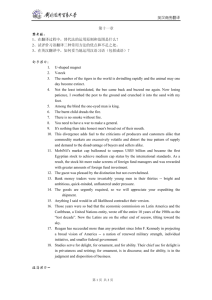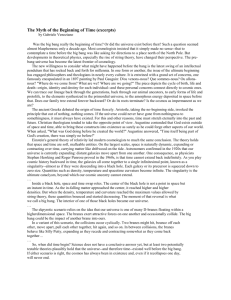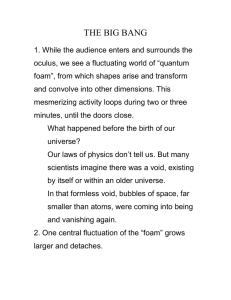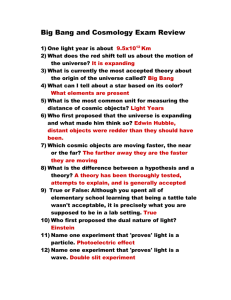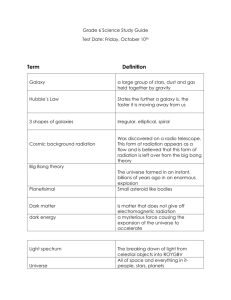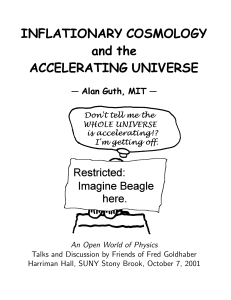Document 13719820
advertisement
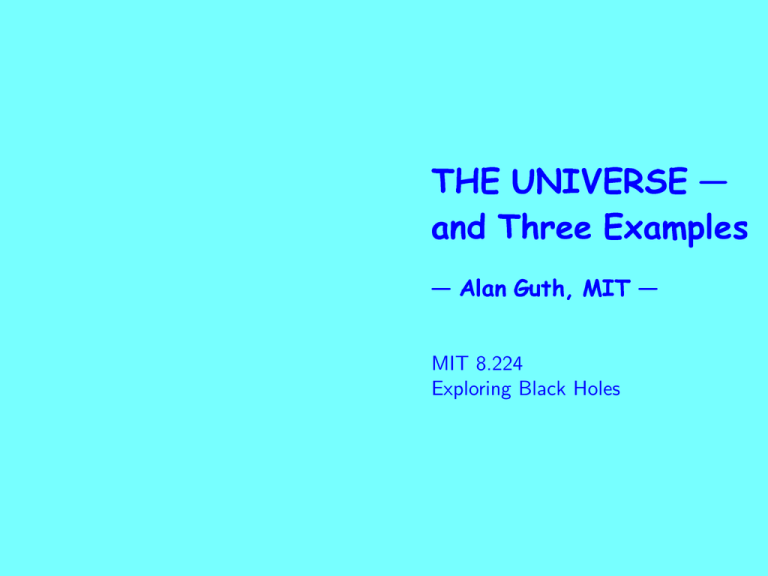
��� �������� � ��� ����� �������� � ���� ����� ��� � MIT 8.224 Exploring Black Holes ���������� ������������� March, 1916: “The Foundation of the General Theory of Relativity” Feb, 1917: “Cosmological Considerations Arising from the General Theory of Relativity” • Unquestioned assumption— static universe • In original version of General Relativity, a static universe is impossible— it would collapse • Einstein introduced “cosmological term”— a universal repulsion — to allow static universe –1– �������� ��� ������ All distant galaxies are receding, with (Note: H is not really a constant, but varies as the universe evolves.) Today, H is believed to lie in the range 0.6 to 0.8 km H ≈ 10 per Mpc . ≈ 60 to 80 10 years sec Hubble Space Telescope Key Project on the Intergalactic Distance Scale (12/2000): km per Mpc . H = 72 ± 8 sec –2– ��� ��������� ����������� �������� –3– ��� ������ ���������� �������� Source: COsmic Background Explorer (COBE), January 1990 Based on 9 minutes of data only! Error bars are 1% of peak intensity December 1996 data: Errors reduced by factor of 200 (to 50 parts per million!), and it is still –4– perfectly in agreement with blackbody curve. T = (2.725 ± 0.002) ◦ K. THE STANDARD BIG BANG What it is: • Theory that the universe as we know it began 10-15 billion years ago. • Initial state was a hot, dense, uniform soup of particles that filled space uniformly, and was expanding rapidly. Evidence: • Hubble’s law (uniform expansion) • Cosmic Microwave Background Radiation • The abundances of the light chemical elements— H, H 2 , He3 , He4 , Li7 — agree well with predictions of big bang nucleosynthesis. What it describes: • How the early universe expanded and cooled • How the light chemical elements formed • How the matter congealed to form stars, galaxies, and clusters of galaxies –5– The Standard Big Bang, cont. What it doesn’t describe: • What caused the expansion? aftermath of the bang.) (The big bang theory describes only the • Where did the matter come from? (The theory assumes that all matter existed from the very beginning.) –6– ��������� • Modern particle theories predict that, at very high energies, there exists a form of matter that creates a gravitational repulsion! • Inflation proposes that a patch of this form of matter existed in the early universe — it was probably more than a billion times smaller than a single proton! • The gravitational repulsion created by this material was the driving force behind the big bang. The repulsion drove it into exponential expansion, doubling in size every 10−37 second or so! • The density of the repulsive gravity material was not lowered as it expanded! –7– • Although more and more mass/energy appeared as the repulsive-gravity material expanded, total energy was conserved! The energy of a gravitational field is negative! The positive energy of the material was compensated by the negative energy of gravity. • The repulsive-gravity material is unstable, so it decayed like a radioactive substance, ending inflation. The decay released energy which produced ordinary particles, forming a hot, dense “primordial soup.” • Inflation lasted maybe 10−35 second. At the end, the region destined to become the presently observed universe was about the size of a marble. • The “primordial soup” matches the assumed starting point of the standard big bang— the standard big bang description takes over. The region continues to expand and cool to the present day. –8– �������� ��� ��������� 1) Large scale uniformity. The cosmic background radiation is uniform in temperature to one part in 100,000. It was released when the universe was about 300,000 years old. In standard cosmology without inflation, a mechanism to establish this uniformity would need to transmit energy and information at about 100 times the speed of light. 2) “Flatness problem:” Why was the mass density of the early universe so close to the critical density? actual mass density , Ω= critical mass density where the “critical density” is that density which gives a geometrically flat universe. At one second after the big bang, Ω must have been equal to one to 15 decimal places! Extrapolating back to the Planck time, 10−43 seconds, Ω must have been one to 58 decimal places! Inflation explains why. Since the mechanism by which inflation explains the flatness of the early universe almost always overshoots, it predicts that even today the universe should have a critical density. –10– 3) Small scale nonuniformity of the cosmic background radiation. Although only at the level of 1 part in 100,000, these nonuniformities can now be measured! The properties measured so far agree beautifully with inflation. –11– ���� ����� �������� ��������� Parameters of theoretical curve (best fit to all CMB data, CBI group, astro-ph/0205388): Ωtot = 1 (naturally) ΩΛ = 0.7 (large dark energy component) ΩCDM = 0.257 (cold dark matter, consistent with astronomical estimates) h = H/(100 km-sec−1 -Mpc−1 ) = 0.68 (Hubble Key Project: h = 0.72 ± 0.08) Ωb h2 = 0.020 (Big bang nucleosynthesis: 0.020 ± .001) ns = 0.95 (nearly scale-invariant) τc = 0 (no absorption) –12– –13– –14– –15– ACCELERATING UNIVERSE? Today there is strong evidence coming from the observation of distant Type Ia Supernova, by two different teams of astronomers, indicating that the cosmic expansion is not slowing down, but is speeding up! This observation strongly supports inflationary theory: • It confirms the theoretical conclusion that gravity can act repulsively. • Acceleration requires “dark energy” permeating space, and the amount needed is just right (± about 10%) to bring the total mass density up to the critical density predicted by inflation. (The makeup is about 1% visible matter, 30% dark matter, and 70% “dark energy”.) –16– SUMMARY 1) The big bang theory is well-supported by evidence: Hubble expansion, cosmic background radiation, light elements. 2) The classic form of the big bang theory does not even attempt to explain the bang. 3) The inflationary theory offers a possible explanation of what started the universe expanding, and can even explain the origin of essentially all the matter and energy. 4) The inflationary theory is also supported by evidence: uniformity on large scales, nature of cosmic background radiation nonuniformities, critical mass density. 5) New observations (supernovae Ia, cosmic background radiation, large scale galaxy surveys) are making cosmology an exciting and rapidly changing field. –18–
